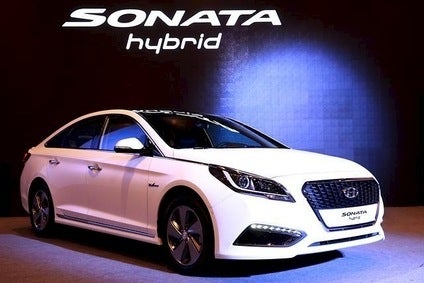
Hyundai has launched its redesigned Sonata Hybrid with “unique hybrid design” styling changes, new safety and convenience features and an upgraded powertrain that delivers claimed class-leading fuel economy of 18.2km/litre.
“The launch of our all-new Sonata Hybrid, with its class-leading fuel economy and powerful driving performance, comes at a time when eco-friendly vehicles are becoming established as mainstream cars,” Jin Kwak, the executive vice president responsible for sales in the domestic market, said at a media event. “Our latest offering, based on one of our best-selling models, underscores our efforts to meet the growing popularity of eco-friendly vehicles around the world.”
The hybrid, the result of 27 months of development costing about KRW180bn Won (KRW), is scheduled to launch in major markets outside Korea, starting in the first half of 2015. The automaker hopes to sell 55,000 units (18,000 in Korea, 37,000 for export) in 2015.
The hybrid will be joined next year by a plug-in variant of the Sonata which will be the automaker’s first PHEV. The first dedicated Hyundai hybrid model in the second half next year.
The new hybrid will make its North American debut at the 2015 Detroit show when more details of the PHEV version will be announced.
The redesigned hybrid is powered by the Nu two-litre GDI hybrid engine mated to a 38kW electric motor. The petrol engine delivers maximum power and torque of 156PS and 19.3kg/m, up 4% and 5.5% respectively, compared to the previous model. The 38kW electric motor also delivers 8.6% improved maximum power with maximum torque of 20.9kg/m (205Nm).

US Tariffs are shifting - will you react or anticipate?
Don’t let policy changes catch you off guard. Stay proactive with real-time data and expert analysis.
By GlobalDataWith the upgraded engine and electric motor, the new model is said to achieve a significant improvement in fuel consumption: a class-leading combined rating of 18.2km/litre with 16-inch wheels (17.7km/litre with 17-inch wheels).
This engine transfers power to the road via a six-speed automatic transmission – a new unit launched in October 2014 at the company’s annual international powertrain conference – which houses almost all of the hybrid powertrain components within the transmission, minimising energy losses and maximising fuel economy.
The transmission is fitted with a traction motor while the torque converter has been removed. A lighter torsion damper and new engine clutch, which features fewer clutch discs, reduce drag and contribute to a more efficient transfer and use of power.
The most significant change to the new transmission to improve fuel efficiency is within the oil pump system. By removing the mechanical oil pump, which causes hydraulic losses, and replacing it with a new electric oil pump, the transmission automatically optimises operation according to the driving conditions.
The hybrid continues to use a lithium-polymer battery pack – which in 2011 made Hyundai Motor the first automaker to incorporate such efficient battery technology into production cars – now with a 13.3% higher capacity of 1.62 kilowatt-hour (versus 1.43kWh). The battery has been relocated under the boot floor, allowing for a flat floor, creating a more useable cargo area, 10.5% larger than that of the previous model, with 60/40 split-folding seats.
As with the first Sonata Hybrid, the new model is based on a full parallel hybrid architecture. The advantages of a full parallel system allow the car to generate electricity captured during low engine loads and regenerative braking system to power the electric motor. When the vehicle comes to a stop and the electrical load is low, the engine will shut down to eliminate idle fuel consumption and emissions.
Unique exterior design features distinguish the new hybrid from non-hybrid models. As well as creating a unique design, these changes have a functional outcome, an exceptionally low drag coefficient of 0.24 Cd for the all-new Sonata Hybrid, aiding fuel efficiency and stability.
At the front, the larger, more sharply-edged hexagonal grille has a unique inner-grille pattern. The hexagonal grille aids cooling and aerodynamic efficiency while there are new, slimline LED daytime running lights and HID headlamps.
Revised rear fenders flow into new, high-visibility LED rear lamp clusters. New, streamlined 16-inch and 17-inch alloy wheels, together with a full underbody cover, contribute to reduced airflow resistance.



